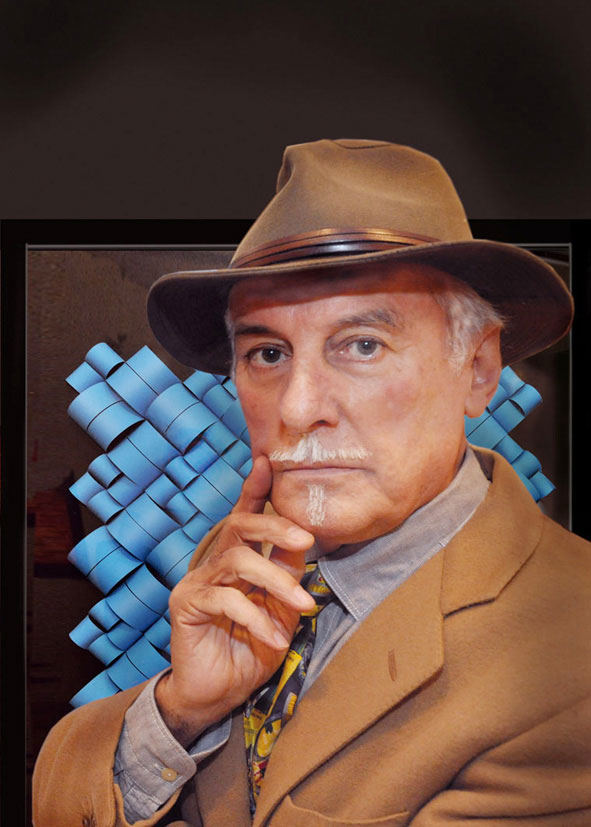
|
DARIO ZAFFARONI
was born in San Vittore Olona (Milan) in 1943
Artistic Development (Translation: Kenneth John Allan)
After taking a Diploma in Industrial Design he began to paint, producing works in a post-informal style. His first one-man show was in 1964
Other exhibitions were held in various places until 1968 when his work took a radical change of direction.
Dario came into contact with the circle of avant-garde Milanese artists including Dadamaino, Calderara, Colombo, Varisco, Minoli, Spagnulo, Nigro, Tornquist….. Sharing their avant-garde ideals led him to abandon the traditional instruments of painting in favour of new methods and languages which involved the use of unusual materials such as special papers, plastics, metals and chromo-luminous projections.
His artistic path has therefore been made up of a series of creative seasons, all directed at continuous research into visual perception.
Zaffaroni began to research into colour in 1969. This formed the basis of a new cycle of works, Cromodinamiche-fluorescenti (Fluorescent chromodynamics), using industrially precoloured fluorescent paper in 10 different shades. The Optical movement of those years was at the base of the projectual nature of these works: the particular chromo-plastic composition of the paper combined with the thrilling chromatism of the fluorescence detemined an optical/kinetic vision of the works as the position of the viewer changed.
In parallel with this, the artist developed the cycle of the Rulli (Bobbins), a series of works using cardboard bobbins partially covered with fluorescent paper arranged according in a sequence which allows the viewer to transform himself into the protagonist: the spectator, by manually rotating the elements, obtained a subjective tactile-kinetic composition of the work.
These works were the object of various personal and collective exhibitions.
In 1970, as part of his professional studies, he participated in the planning of programmed environments, Environnement. He also made external contributions: he was assistant to Dadamaino at the Campo Urbano di Como display where, in the evening, a thousand floating fluorescent tiles were set adrift on the waters of the harbour, creating “self-moving” luminous reflections.
In 1970 at the invitation of C.N.A.C. - Centre National d'Art Contemporain Zaffaroni along with Dadamaino presented the project of 20 Environnement lumino-cinétique shown in the Place du Châtelet in Paris. This was judged to be the second best project, after that of Christo, out of 110 proposals.
In 1971 Zaffaroni together with Dadamain and M. Mondani at the invitation of the Central Artistic Environment of the “Catchword Potash Mine” of Bad-Salzdetfurth - the German mining town - proposed a project made up of a series of artistic creations aimed at the defence of local ecosystems: the project became a travelling exhibition, visiting various European cities.
In 1972 Zaffaroni joined Dadamaino, M. Mondani, and G. Cajelli to form “Il Collettivo di Controinformazione Milano” (The Milan Counter-information Collective), participating in various artistic shows with critical, counter-persuasive works designed to demistify the debatable nature of advertising messages and to frustrate the consumerist impact.
In 1973 Zaffaroni - as part of the Artisti del Borgo Collective and with the involvement of local residents in the Nuova Torretta district - made a corridor/labyrinth for the “13th Piazzetta Artisti nel quartiere” event in Sesto San Giovanni (Milan). Inside this, the co-creator/visitor could set the proposed artistic iconography against his/her own daily reality. This work, dqly documented, was re-presented again in 1976 at the Biennale di Venezia / Ambiente come Sociale.
In 1975, three of his works were presented at the 10th Rome Quadriennial "The New Generation". Zaffaroni with E. Tadini and C. D'angelo was amongst the Italian artists invited to the “X Internazionale Malerwochen” in Graz, Austria. As a guest of the Agricultural University of Gleisdorf, he created large 5 works which were bought by and shown at the Neue Galerie am Landesmuseum Joanneum in Graz.
In 1976 the course of his Chromodynamics study enabled him to achieve significant results, both artistic and analytic, in the use of fluorescent colours. Having taken this research to almost insuperable limits and also feeling a need to shift his creativity towards expressions which were more uncontrolled, more accidental, he began a new cycle of works - Chromo-optical.
This was based on the repeated positioning of randomly coloured “x” symbols on a predefined ground until an indeterminate Chromatic Surface was created, displaying almost imperceptible patterns caused by the coincidental elements.
In 2000 the Chromo-optical cycle of works underwent an evolution in its component language. The “x” symbol was substituted by a chromatic mosaic background into which a verbal element was inserted in order to alternate the indeterminability of the chromatic surface with the visual-conceptual registration of the word displayed. The manual elaboration of these works was carried out exclusively with the use of technological instruments such as Macintosh computers and digital plotters. In contemporary terms, these works are defined as "Digital Texture". |
|